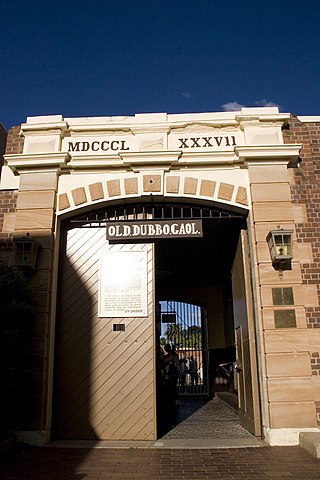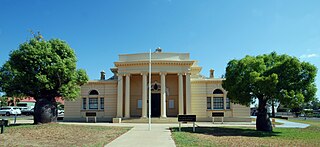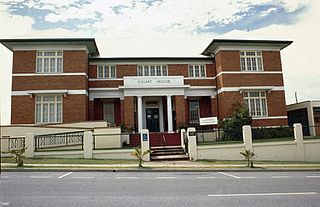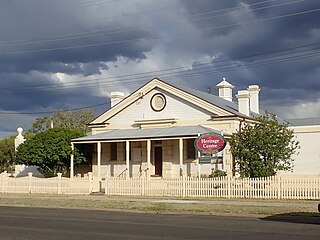
The Old Dubbo Gaol is a heritage-listed former gaol and now museum and tourist attraction at 90 Macquarie Street, Dubbo in the Dubbo Regional Council local government area of New South Wales, Australia. The gaol was designed by the NSW Colonial Architect's Office and was built from 1847 to 1945 by James Atkinson Jnr (1862–63) and William Bonython Moffatt. The gaol is also known as the Dubbo Jail and the Dubbo Gaol. The building was added to the New South Wales State Heritage Register on 26 March 2004. The building was the second gaol in Dubbo, replacing lockups built in 1847 and 1862.

Mortimer William Lewis was an English-born architect, surveyor and public servant who migrated to Australia and became Colonial Architect in the colony of New South Wales from 1835 to 1849. Lewis was responsible for designing and overseeing many government buildings in Sydney and rural New South Wales, many of which are heritage listed.

Maryborough Courthouse is a heritage-listed courthouse at 170 Richmond Street, Maryborough, Fraser Coast Region, Queensland, Australia. It was designed by Francis Drummond Greville Stanley and built in 1877 by John Thomas Annear for the Queensland Government. It is also known as Maryborough Court House and Government Offices. It was added to the Queensland Heritage Register on 21 October 1992.

Roma Courthouse is a heritage-listed courthouse at 141 McDowall Street, Roma, Maranoa Region, Queensland, Australia. Constructed in 1901, the courthouse is a rendered masonry building, which is still in use today. Predominately influenced by the Federation free style, it is considered a stunning example of Federation colonial architecture at its best. It is also known as Roma Court House and Roma Police Buildings. It was added to the Queensland Heritage Register on 7 August 1998.

Bowen Courthouse is a heritage-listed courthouse at 30 Williams Street, Bowen, Whitsunday Region, Queensland, Australia. It was designed by George St Paul Connolly of the Colonial Architect's Office and built in 1880 by Southall & Tracey. It is also known as Bowen Court House. It was added to the Queensland Heritage Register on 21 October 1992.

The Old Cleveland Police Station is a heritage-listed police station at 1 Passage Street, Cleveland, City of Redland, Queensland, Australia. It was built from 1934 to 1935. It was added to the Queensland Heritage Register on 26 March 1999.

Gympie Lands Office is a heritage-listed former court house and public administration building at 26 Channon Street, Gympie, Queensland, Australia. It was designed by Queensland Department of Public Works and Queensland Colonial Architect's Office and built in 1942 by the Department of Public Works, Gympie City Council, Mark Doggett, Andrew Collins, and George Caldwell. It was added to the Queensland Heritage Register on 15 July 2011.

Gladstone Court House is a heritage-listed courthouse at 16 Yarroon Street, Gladstone, Gladstone Region, Queensland, Australia. It was designed by Raymond C Nowland and built from 1940 to 1942. It was added to the Queensland Heritage Register on 29 May 1998.

The Justice and Police Museum is a heritage-listed former water police station, offices and courthouse and now justice and police museum located at 4-8 Phillip Street on the corner of Albert Street, in the Sydney central business district in the City of Sydney local government area of New South Wales, Australia. It was designed by Edmund Blacket, Alexander Dawson and James Barnet and built from 1854 to 1886. It is also known as Police Station & Law Courts (former) and Traffic Court. The property is owned by the Department of Justice, a department of the Government of New South Wales. It was added to the New South Wales State Heritage Register on 2 April 1999.

The Central Local Court House or Police Law Courts or Central Police Court is a heritage-listed building located at 98 Liverpool Street, in the central business district of Sydney, New South Wales in Australia. Constructed in the Federation Free Classical style based on original designs by Colonial Architect, James Barnet, the building structure was completed in 1892 under the supervision of Barnet's successor, Government Architect, Walter Liberty Vernon. It is also known as Sydney Central Local Court House, Police Law Courts and Central Police Court. The property is owned by the Department of Justice, a department of the Government of New South Wales. It was added to the New South Wales State Heritage Register on 2 April 1999. The court house is located in a precinct that includes the Downing Centre, and buildings housing the Family Court of Australia and the Federal Circuit Court in Sydney. Adjacent to the court house is Brickfield Place, a brick paved courtyard with seating and planter boxes, constructed in 1892, assessed as a good example of urban design for public open space.
The Bundarra Police Station and Courthouse is a heritage-listed former police station and courthouse located at Oliver Street, Bundarra, in the Uralla Shire, New South Wales, Australia. It was designed by James Barnet and built from 1869 to 1870 by Alfred Dorrey. The property is owned by Bundarra Community Purposes Reserve Trust. It was added to the New South Wales State Heritage Register on 2 April 1999.

The Narrabri Gaol and Residence is a heritage-listed former gaol and now museum at Bowen Street, Narrabri, Narrabri Shire, New South Wales, Australia. The building was designed by James Barnet and built from 1880 to 1881 by J. Conlon. The property is owned by Narrabri Shire Council and was added to the New South Wales State Heritage Register on 2 April 1999.
Hastings Historical Society Museum is a heritage-listed former retail store and now museum at 22 Clarence Street, Port Macquarie, Port Macquarie-Hastings Council, New South Wales, Australia. It was built from 1835 to 1840 by William Stokes. It is also known as Port Macquarie Historical Society Museum and Port Macquarie Museum. It was added to the New South Wales State Heritage Register on 2 April 1999.

St Thomas' Anglican Church is a heritage-listed Anglican church at Hay Street, Port Macquarie, Port Macquarie-Hastings Council, New South Wales, Australia. It was built from 1823 to 1827 by convict labour under military supervision. The property is owned by the Anglican Diocese of Grafton. It was added to the New South Wales State Heritage Register on 18 October 2002.

Port Macquarie Government House Site is a heritage-listed archaeological site at 2 Clarence Street, Port Macquarie, Port Macquarie-Hastings Council, New South Wales, Australia. It was built from 1824 to 1826 by convict labour. The property is owned by Port Macquarie-Hastings Council. It was added to the New South Wales State Heritage Register on 3 August 2001.

The Greenway Wing of the Supreme Court of New South Wales is a heritage-listed courthouse located at the junction of King and Elizabeth Streets, in the Sydney central business district, in the City of Sydney local government area of New South Wales, Australia. It was designed by Francis Greenway, Standish Lawrence Harris, and James Barnet and built from 1820 to 1828. It is also known as Sydney Supreme Court House (Old Court House) and Old Court House. The property is owned by the Department of Justice and Attorney General, departments of the Government of New South Wales. It was added to the New South Wales State Heritage Register on 2 April 1999.

Richmond Post Office is a heritage-listed former post office at 286 Windsor Street, Richmond, City of Hawkesbury, New South Wales, Australia. It was designed by Colonial Architect James Barnet and built from 1875 to 1888. The original building was built by a Mr. Johnson, with the second-story addition in 1888 added by Samuel Bought. It is also known as Richmond Telegraph and Post Office. It was added to the New South Wales State Heritage Register on 23 June 2000.

Windsor Court House is a heritage-listed courthouse at Court and Pitt Streets, Windsor, City of Hawkesbury, New South Wales, Australia. It was designed by Francis Greenway with a later extension by James Barnet and built from 1821 to 1822 by William Cox. It was added to the New South Wales State Heritage Register on 2 April 1999.

Thompson Square Conservation Area is a heritage-listed precinct centred around Thompson Square in Windsor, City of Hawkesbury, New South Wales, Australia. It was added to the New South Wales State Heritage Register on 2 April 1999.

The Old Police Station, The Rocks is a heritage-listed former police station and now home to Sergeant Lok, a Modern Asian restaurant and bar, that is located at 127–129 George Street in the inner city Sydney suburb of The Rocks in the City of Sydney local government area of New South Wales, Australia. It was designed by James Barnet and built in 1882 by W. Cains and Sons. The property is owned by Property NSW, an agency of the Government of New South Wales. It was added to the New South Wales State Heritage Register on 10 May 2002.



















